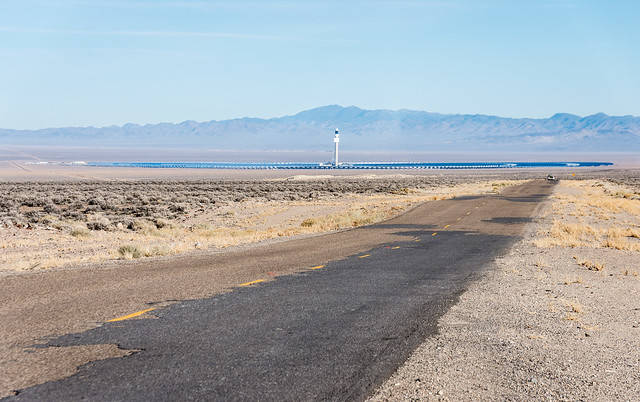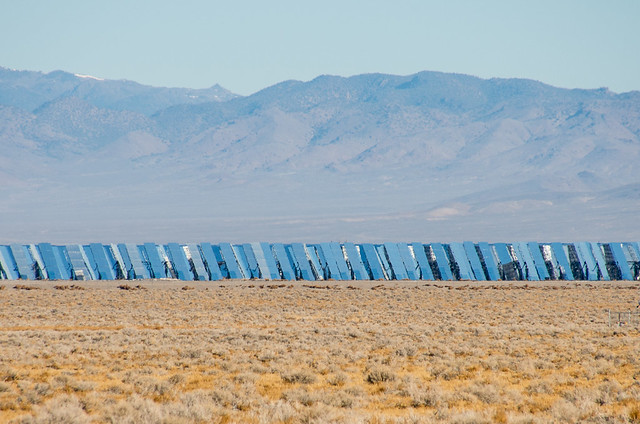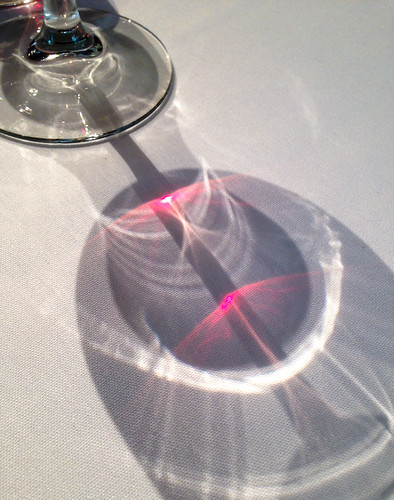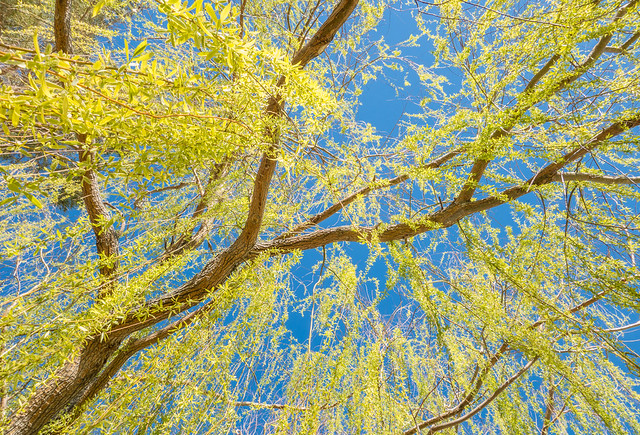At Mizpah we had Cline wine with our supper. We normally try to drink local wine when we're traveling but the Clines own the Mizpah so we figured we might as well drink their wine. Especially since they had a Lady in Red blend specifically made for the hotel (named after a famous murder!) And we knew we'd get some Nevada wine later (see below)
From our hotel window we could catch a glimpse of the Solar Reserve project. It didn't look too far away so in the morning we decided to check it out. It's hard to get a good view of it. You'd either need to get an aerial view or to walk amongst the mirrors (heliostats). The mirrors focus the sun onto a tower where it heats molten salt which is the used to run steam generators. There are a number of nice features of this technology. First, mirrors are a lot easier to manufacture than photovoltaic panels. (Although the aiming is trickier.) Second, the molten salt allows short term storage of power so it will be able to produce power 24 hours a day and easily ramp up or down depending on demand. (Something wind power can't easily do.)


Driving south from Tonopah it wasn't long before we started seeing Joshua Trees, one of my desert favourites. A few of them were flowering, usually a sign of recent rain. Like other yuccas, they are actually a member of the lily family. They were named by early Mormons who thought it looked like the upraised arms of Joshua placating God. It's interesting how there can be so many of them in certain places and none in others. One theory is that they were spread by giant ground sloths, which of course no longer exist. (One of many animals that "mysteriously" disappeared right about the same time that humans arrived in North America.). Joshua Trees are also quite sensitive to climate and its predicted that they will die out as the climate changes. Sadly, Joshua Tree National Park may soon lose its namesake trees.
For a number of years we've been trying to get to the Pahrump winery. It worked out well this time - coming from Tonopah we could easily skirt Las Vegas and stop at the winery for lunch. The town of Pahrump isn't anything special but the winery is in a nice setting with its small vineyards, trees, and flowers. They only grow grapes for red wines since the summers are too hot for white wine grapes. The grapes near the winery were mostly Zinfandel.

The willow trees were just starting to get their leaves. From a distance it looked like they were dusted with green. Apparently that's a sign that it's time to prune the grape vines since they will also get their leaves soon.

From Pahrump we could take the road past Red Rocks and in on Charleston Avenue, one of the few ways to get into Vegas without freeway hell. As usual, we're staying at the La Quinta in Summerlin, well away from the circus of the strip, and close to the Red Rocks side of town. Given that Saskatoon is still deep in winter it is a real treat to see the flowering trees here.

From our hotel window we could catch a glimpse of the Solar Reserve project. It didn't look too far away so in the morning we decided to check it out. It's hard to get a good view of it. You'd either need to get an aerial view or to walk amongst the mirrors (heliostats). The mirrors focus the sun onto a tower where it heats molten salt which is the used to run steam generators. There are a number of nice features of this technology. First, mirrors are a lot easier to manufacture than photovoltaic panels. (Although the aiming is trickier.) Second, the molten salt allows short term storage of power so it will be able to produce power 24 hours a day and easily ramp up or down depending on demand. (Something wind power can't easily do.)


Driving south from Tonopah it wasn't long before we started seeing Joshua Trees, one of my desert favourites. A few of them were flowering, usually a sign of recent rain. Like other yuccas, they are actually a member of the lily family. They were named by early Mormons who thought it looked like the upraised arms of Joshua placating God. It's interesting how there can be so many of them in certain places and none in others. One theory is that they were spread by giant ground sloths, which of course no longer exist. (One of many animals that "mysteriously" disappeared right about the same time that humans arrived in North America.). Joshua Trees are also quite sensitive to climate and its predicted that they will die out as the climate changes. Sadly, Joshua Tree National Park may soon lose its namesake trees.
For a number of years we've been trying to get to the Pahrump winery. It worked out well this time - coming from Tonopah we could easily skirt Las Vegas and stop at the winery for lunch. The town of Pahrump isn't anything special but the winery is in a nice setting with its small vineyards, trees, and flowers. They only grow grapes for red wines since the summers are too hot for white wine grapes. The grapes near the winery were mostly Zinfandel.

The willow trees were just starting to get their leaves. From a distance it looked like they were dusted with green. Apparently that's a sign that it's time to prune the grape vines since they will also get their leaves soon.

From Pahrump we could take the road past Red Rocks and in on Charleston Avenue, one of the few ways to get into Vegas without freeway hell. As usual, we're staying at the La Quinta in Summerlin, well away from the circus of the strip, and close to the Red Rocks side of town. Given that Saskatoon is still deep in winter it is a real treat to see the flowering trees here.

No comments:
Post a Comment